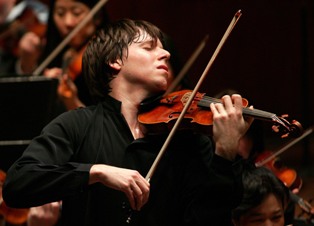
Joshua Bell Closes Inaugural Constella Festival on a High Note

Joshua Bell
|
It was the perfect concert, you might say: one of the world’s best violinists, playing to a packed, intimate hall, enthusiastic listeners, a feeling of ownership of the event . . .
There was even a nod to Cincinnati history.
It was violinist Joshua Bell, performing Tuesday evening (Nov. 8) in Memorial Hall with pianist Sam Haywood on the final concert of Cincinnati’s new Constella Festival of Music and Fine Arts, which made its debut this fall.
The beginning was delayed fifteen minutes to accommodate the large number of walk-up ticket buyers, but no one was complaining. It has been a decade since Bell’s last performance here, and it was an event.
Though he did not specifically plan it that way, Bell’s program was uniquely tailored for Cincinnati since it contained a sonata by Eugène Ysaÿe. The great Belgian violinist was conductor of the Cincinnati Symphony Orchestra from 1918-22.
Also on the program were sonatas by Mendelssohn, Beethoven and César Franck. All in all, it was a program of beauty, substance and arresting virtuosity.
No small bit of it had to do with Haywood, a superb pianist, who performed using an I-Pad instead of music and turning the pages with his foot.
Mendelssohn’s F Major Violin Sonata (unpublished during his lifetime and re-introduced to the repertoire by Yehudi Menuhin in 1953) made a bright, optimistic opener, with its heroic opening statement. The lovely Adagio grew passionate as it went on and the finale was downright jolly.
Beethoven’s Violin Sonata Op. 30 No. 2 is in his tempestuous key of C Minor (think his Symphony No. 5). Bell and Haywood gave it exactly that characterization. Indeed Bell’s shaping of the opening motif – a six-note figure with a crescendo in the middle – made an immediate emotional impact. Bell’s tone production was amazing here (he plays a priceless Stradivarius violin) and in the slow movement, his sound suggested nothing so much as the petals of a rose. He and Haywood made great fun of the Scherzo and brought the first half to a close with a splendid, emotionally suffused reading of the Allegro Presto finale.
Having studied with Josef Gingold at Indiana University, Bell can claim a direct link to Ysaÿe, who was Gingold’s teacher. However, it was Ysaÿe’s connection with César Franck and his Violin Sonata in A Major that dictated his choice to program them back-to-back on this tour. Franck dedicated the Sonata to Ysaÿe and gave it to him on his wedding day in 1886 (when, after a quick rehearsal, Ysaÿe promptly premiered it). Ysaÿe was inspired to write his Op. 27 Sonatas by Bach’s solo works for violin. Bell’s performance of No. 3, subtitled “Ballade,” was awe-inspiring. From the harmonically daring introduction through the complex Allegro (thickets of notes), he articulated it vividly, always punching out the movement’s dotted-note motif clearly and with drama.
Like his great D Minor Symphony, Franck’s Violin Sonata is a cyclic work (i.e. it uses the same themes or motifs throughout for unity). It is a gorgeous work, one of the peaks of the violin literature. (Going back to Ysaÿe, his advocacy of it helped bring Franck’s music to recognition.) Bell and Haywood gave it a performance to match. It began low and soft in the piano, with a dreamy little melody for the violin. The two musicians matched each other perfectly. The turbulent Allegro (second movement) was another opportunity to relish Bell’s sound production. With his exquisite bow control, it could go from burgundy-colored and full-bodied to, uncannily enough, passages where his Stradivarius seemed to take on the color of Haywood’s Steinway.
The third movement introduced the work’s impassioned “big theme” (repeated in the finale), given heart-rending expression by Bell, who performed with considerable physicality, swaying, dipping and invariably turning to the right with a little flourish at the end of a work. The finale itself, opening with a genial canon (passages played in imitation), was glorious in its summation and brought the audience to its feet, with whistles, bravos and unanimous acclaim.
For an encore, Bell and Haywood performed Bell’s own transcription of Chopin’s Nocturne in C-sharp Minor (Ysaÿe the composer would have approved.)
Following the concert, there were refreshments and an art exhibit in the first floor meeting rooms, where Bell also signed programs and CDs. Curated by Stewart Goldman, the art show included numerous works “with a message,” i.e. Goldman’s own “Congressional Caucus Surrounded by a Sea of Pain” – a wood frame centered in blue fabric -- and Jill Rowinski’s “Let Them Eat Cake” – a side chair covered in plastic with a “cake” frosted with roses in front.
The inaugural Constella Festival, founded by artistic director Tatiana Berman, has been a resounding success. With 13 concerts Oct. 13-Nov. 8, it has fostered collaboration among Cincinnati’s chamber music groups, featured world class performers, multi-media programming and introduced new works to the repertoire. For information, see www.constellafestival.org